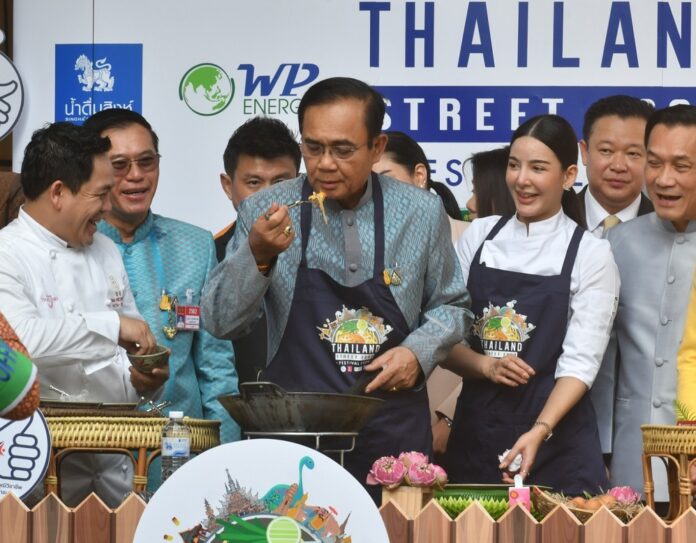
What is the Thai national dish? Last Thursday, the opposition Pheu Thai Party called for the government to promote pad thai as Thailand’s soft power. This inadvertently led to a debate on social media whether pad that deserves to be the unofficial national dish of Thailand. Pad kra pao, or chicken or other meat stir-fried with holy basil were mentioned by many netizens as the real national dish.
I will not get into this highly contentious topic because I do not think Thailand needs to have one single national dish. Our rich culinary heritage means there are many Thai dishes worthy to be enjoyed and promoted around the world. Pad thai is definitely already well-known internationally, so are tom yum goong, som tum, massaman and more.
The same can be said about Japanese or French food, for example, you would not be able to pin down one dish as a national dish, there are just a variety of thoroughly enjoyable dishes worthy of appreciation around the globe.
So here I am not going to get into the pointless debate but start by saying that some Thai dishes are already well-known in cosmopolitan cities around the globe but the government (and all of us Thais) can do more to promote them.
Hear me on what can and should be done.
1. The government should set up a semi-governmental organization, whose main task is to promote Thai food abroad and ensure Thai food excellence at home. This body could be called the “Council for Thai Food Excellence” and the budget could be allocated from the Ministry of Culture. It will need to work closely with the Tourism Authority of Thailand, the Foreign Ministry, as well as the Ministry of Agriculture.
Half of the council members should be filled mostly with non-bureaucrats, but culinary experts and celebrity chefs tasked with finding strategies to improve and promote Thai food in Thailand and abroad. Without this dedicated body, there will be nobody to play a permanent host to uplift Thai food in a coordinated fashion.
I am well aware that many Thais and non-Thais are already promoting Thai food abroad by opening restaurants, food trucks, and more and the task of the government, through this council, is to find way to support those who offer authentic and quality Thai food by, for example, giving them a stamp of approval through certificate of Thai food excellence.
2. We need an annual national food competition to improve the taste, quality, and nutrition of famous Thai dishes. Why not start with a national pad thai or pad kra pao competition with some substantial award and recognition. The same should be done with rice, fermented fish sauce or nam pla, and even popular fruits such as mango, durian and more.
3. Time to support local alcoholic beverages like rice wine, craft beer, and even wine and more. Two giant breweries have maintained a control over the vast majority of the Thai alcohol beverage market for too long and it is appalling that when dining at a Thai restaurant abroad, your Thai alcoholic beverage is a choice between Singha or Chang.
4. Quality and basic ingredients will do more to improve Thai food. Rice, for example, needs to be better promoted at the upper end of the market, quality jasmine rice and others should be promoted as geographically indicated. There are currently 18 types of Thai rice recognized with geographical indications, but the government should do more to promote it both locally and abroad.
It’s a shame that most Thai restaurants do not even offer quality Thai rice and most well-to-do Thais do not care about these unique variety of Thai rice. Time to raise the profile and promote quality rice, as well as fruits, so farmers can earn more. We can keep on competing with Vietnam or Indonesia in lower-end rice price.
5. Pay attention to new ingredients and fusion Thai cuisine. Has anyone noticed that that too-scary pink salmon is invading many local Thai dishes as an ingredient for Thai food? Larb salmon or yum pla salmon, or varieties of salmon spicy salad are now quite common in Bangkok and beyond and again, the council could fine tune and host a competition in hope of raising both its taste, quality and profile abroad.
I mean, it is easy for those in the West or East Asia to appreciate them since salmon is not alien to their taste buds and easy to obtain. At a recent working lunch hosted by Swedish Ambassador Jon Åström Gröndahl, food was outsourced from Thai restaurant Blue Elephant, and tom saab salmon, a traditional northeastern style spicy soup with salmon and fresh herbs was served.
6. The TAT and the council, as well as the Foreign Ministry, can promote a single annual dish abroad, to widen the range of foreigner’s knowledge and appreciation of these dishes.
7. The list can go on but basically, we need a competent host and organization specifically geared toward improving and promoting Thai food, not once in a blue moon extravaganza where taxpayers’ money is wasted. Thai food is already part of many foreigners’ diets, now we need to widen their knowledge, to let them know that there’s more to the few dishes already well known, and that it’s good for their stomach and health as well.












































